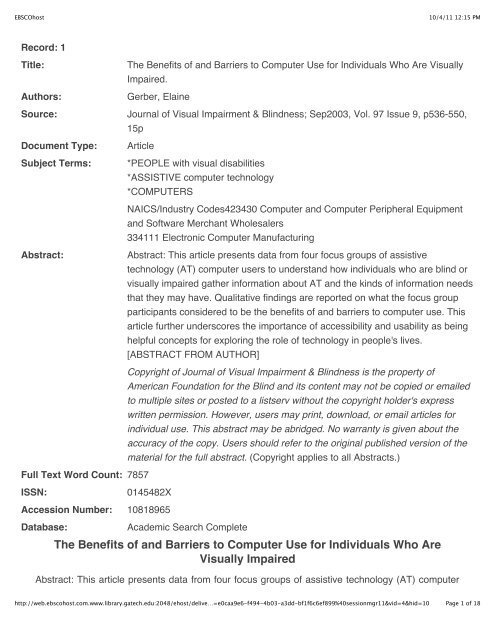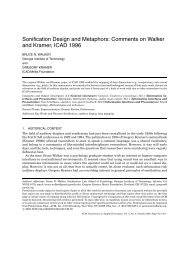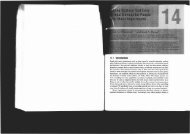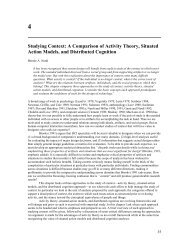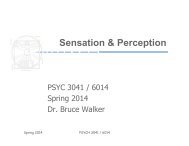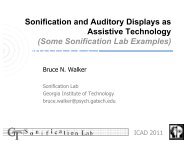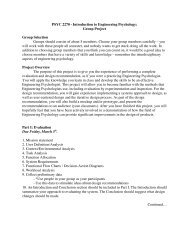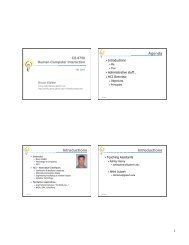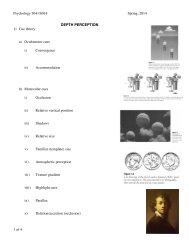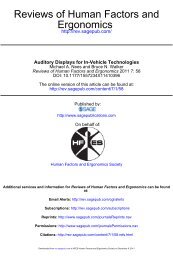The Benefits of and Barriers to Computer Use for Individuals Who ...
The Benefits of and Barriers to Computer Use for Individuals Who ...
The Benefits of and Barriers to Computer Use for Individuals Who ...
You also want an ePaper? Increase the reach of your titles
YUMPU automatically turns print PDFs into web optimized ePapers that Google loves.
EBSCOhost10/4/11 12:15 PMcan shed some light on the behavior <strong>of</strong> computer users who are visually impaired. Although NTIA'ssample was large enough <strong>to</strong> include an estimate <strong>for</strong> visually impaired individuals, the number itreported does not necessarily represent the situation <strong>for</strong> most people with visual impairments inthe United States, since, unlike the previous survey (NTIA, 2000), the 2002 survey included onlypeople with disabilities who were in the labor <strong>for</strong>ce (that is, those who were either employed orwere actively looking <strong>for</strong> work); people who were not working because <strong>of</strong> a "disability" were notincluded. For the population <strong>of</strong> working-age adults ( 25-60year olds in 2001), the survey indicatedthat visually impaired people used computers more <strong>of</strong>ten than did nondisabled, sighted individuals<strong>for</strong> the following tasks: playing games; searching <strong>for</strong> in<strong>for</strong>mation on products or services; makingonline purchases; <strong>and</strong> gathering in<strong>for</strong>mation on news, weather, <strong>and</strong> sports. It also indicated thatpeople who were visually impaired used computers at nearly the same rate as did sighted people<strong>for</strong> e-mail <strong>and</strong> <strong>for</strong> obtaining in<strong>for</strong>mation on health issues <strong>and</strong> at a slightly lower rate <strong>for</strong> findinggovernmental in<strong>for</strong>mation.While the 2002 NTIA survey is by far the most comprehensive federal attempt <strong>to</strong> map the changingdemographics associated with computer use, little is known about the contexts in which allindividuals with visual impairments use computers <strong>and</strong> other AT, what barriers they have <strong>to</strong> usingthem, <strong>and</strong> what benefits they derive from their use.A growing body <strong>of</strong> data is also being compiled on which accessibility features <strong>for</strong> computerhardware <strong>and</strong> s<strong>of</strong>tware <strong>and</strong> <strong>for</strong> the Internet, from a technological st<strong>and</strong>point (e.g., the presence <strong>of</strong>alt-tags, or hidden navigation bars) are necessary <strong>for</strong> visually impaired people <strong>to</strong> use computers<strong>and</strong> the Internet (see World Wide Web Consortia, W3C, 2003). This work is essential, but it doesnot address the user end <strong>of</strong> the experience. In other words, these guidelines were drafted <strong>for</strong> a"universal" user--one who has the latest s<strong>of</strong>tware <strong>and</strong> hardware <strong>and</strong> knows how <strong>to</strong> use them deftly.<strong>The</strong> user end <strong>of</strong> the experience has been predominantly examined by mainstream computerpr<strong>of</strong>essionals, who are only now beginning <strong>to</strong> grapple with the complexities that the diversepopulation <strong>of</strong> users with disabilities brings <strong>to</strong> the equation (Nielsen, 2001). Only a h<strong>and</strong>ful <strong>of</strong>computer pr<strong>of</strong>essionals specialize in the experience <strong>of</strong> visually impaired computer users (Barnicle,2000; Gerber, 2002; Slatin & Rush, 2003).Research in the field <strong>of</strong> visual impairments has, <strong>to</strong> a large extent, taken <strong>for</strong> granted that technologyhas a huge impact on the lives <strong>of</strong> people who are visually impaired. Many pr<strong>of</strong>essionals in the fieldunderst<strong>and</strong>, at least anecdotally, that computer use, AT, <strong>and</strong> access <strong>to</strong> the Internet can make atremendous difference in the lives <strong>of</strong> individuals with visual impairments--improving educational<strong>and</strong> employment opportunities, enhancing social networks (by e-mail <strong>and</strong> online groups), <strong>and</strong>facilitating independence (with personal access <strong>to</strong> in<strong>for</strong>mation). Yet little research, particularlyqualitative research, has been conducted <strong>to</strong> document the importance <strong>of</strong> computers <strong>and</strong> computerrelatedAT, in the lives <strong>of</strong> individuals who are visually impaired. A few relevant studies (e.g.,Brunken, 1984; Craver & Bur<strong>to</strong>n-Radzely, 1998; Crudden & Fireison, 1997; Foulke, 1981; Mather,http://web.ebscohost.com.www.library.gatech.edu:2048/ehost/delive…=e0caa9e6-f494-4b03-a3dd-bf1f6c6ef899%40sessionmgr11&vid=4&hid=10Page 3 <strong>of</strong> 18
EBSCOhost10/4/11 12:15 PMAFB's PRPE department conducted four focus groups, designed <strong>to</strong> elicit in<strong>for</strong>mation aboutcomputer use. Qualitative methods were selected as the most appropriate because we wanted <strong>to</strong>underst<strong>and</strong> the breadth <strong>of</strong> the issue, the range <strong>and</strong> scope, not the frequency <strong>of</strong> such opinions (<strong>for</strong>further in<strong>for</strong>mation on qualitative methods, see Denzin & Lincoln, 1998; Strauss & Corbin, 1998).Furthermore, qualitative methods may be used successfully <strong>to</strong> collect an "emic," or insider's view,from the group being studied <strong>and</strong> there<strong>for</strong>e produce valid descriptions <strong>of</strong> how the group orparticipants perceive various phenomena (Pat<strong>to</strong>n 1990; Pel<strong>to</strong> <strong>and</strong> Pel<strong>to</strong> 1978; Spradley 1980). Inother words, qualitative methods have strong validity (that is, they reflect the concept they areintended <strong>to</strong> measure; see Rossi & Freeman, 1989). Last, qualitative methods are better than arequantitative methods <strong>for</strong> probing <strong>for</strong> in<strong>for</strong>mation about complex behaviors <strong>and</strong> in sensitive contexts(see Barnes & Mercer, 1997; Scrimshaw 1990). Moreover, they are appropriate when there is alow frequency <strong>of</strong> respondents, costs prohibit gathering data in other ways, or one is seekingtargeted viewpoints (e.g., the views <strong>of</strong> AT experts or users who were also teachers). <strong>The</strong> lowprevalence <strong>of</strong> visual impairment in the United States, particularly among computer users, madethis project well suited <strong>to</strong> the use <strong>of</strong> qualitative methods.FOCUS GROUPSPRPE conducted four focus groups in 2001: two at the annual conventions <strong>of</strong> organizations <strong>of</strong>consumers <strong>of</strong> services <strong>for</strong> people who are blind or visually impaired (American Council <strong>of</strong> theBlind, ACB, <strong>and</strong> National Federation <strong>of</strong> the Blind, NFB) <strong>and</strong> one at the biannual, internationalconference <strong>of</strong> the Association <strong>for</strong> Education <strong>and</strong> Rehabilitation <strong>of</strong> the Blind <strong>and</strong> Visually Impaired;one focus group with subscribers <strong>to</strong> AFB's publication, AccessWorld: Technology <strong>and</strong> People withVisual Impairments, was conducted by telephone. All the groups were moderated by the author<strong>and</strong> lasted approximately two hours. <strong>The</strong> sessions were audiotaped, transcribed, <strong>and</strong> analyzedusing qualitative analysis s<strong>of</strong>tware, the Ethnograph.Although the purpose <strong>of</strong> the focus groups was not <strong>to</strong> gather consensus on a particular <strong>to</strong>pic (as itis in focus groups conducted <strong>for</strong> market research purposes), the results presented here indicatethat the participants all felt strongly about these issues <strong>and</strong> were nearly always in agreement(unless where indicated). I was surprised at both the depth <strong>of</strong> feeling that was evoked <strong>and</strong> by thedegree <strong>of</strong> consensus that was reached. Clearly, these were pertinent issues <strong>to</strong> the usersthemselves.<strong>The</strong> data were elicited through an "icebreaker" question, which was also used in the larger projectmentioned earlier: <strong>Individuals</strong> were asked <strong>to</strong> identify one way in which technology has either beenmost helpful or most frustrating <strong>to</strong> them.RELIABILITY AND VALIDITYEven though the participants were asked one way in which computers were either most helpful ormost frustrating, this question opened floodgates, with individuals frequently listing both. Thishttp://web.ebscohost.com.www.library.gatech.edu:2048/ehost/delive…=e0caa9e6-f494-4b03-a3dd-bf1f6c6ef899%40sessionmgr11&vid=4&hid=10Page 5 <strong>of</strong> 18
EBSCOhost10/4/11 12:15 PMquestion struck a nerve. It was something these participants felt was exceedingly important <strong>and</strong>had not yet been discussed this way with others. Although the participants may have engaged inin<strong>for</strong>mal venting in electronic discussion groups or among friends, they had not yet had theopportunity <strong>to</strong> see this as a collective issue faced by others, that is, as a systemic, rather than anindividual, problem. Moreover, they had not had anyone "from the outside" inquire about it. <strong>The</strong>fact that AFB was soliciting in<strong>for</strong>mation on the subject validated a huge host <strong>of</strong> issues that they felthad previously lacked a <strong>for</strong>malized voice. <strong>The</strong>ir outpouring reflected a collective sigh <strong>of</strong> relief thatthese issues were finally being heard. In other words, these themes have what qualitativeresearchers consider both high reliability <strong>and</strong> validity.SAMPLE<strong>The</strong>re were 8-12 individuals in each group, 41 participants in <strong>to</strong>tal, representing a diverse group.PRPE gathered as diverse a sample as possible with regard <strong>to</strong> gender, geographic region, level <strong>of</strong>computer/technical expertise, degree <strong>of</strong> visual impairment, <strong>and</strong> preferred reading method.<strong>The</strong> participants were asked how they rated themselves as users <strong>of</strong> AT, using the followingdefinitions: "beginner" (someone in need <strong>of</strong> training), "expert" (someone who can give training),<strong>and</strong> "intermediate" (somewhere in between). Approximately half the participants were experts; lessthan one fifth were beginners. Half the participants described themselves as "having no usablevision"; the other half varied as <strong>to</strong> their degree <strong>of</strong> visual impairment. Half the participants preferredbraille as their primary reading medium. With regard <strong>to</strong> the age <strong>of</strong> onset, just under half theparticipants had been blind since birth, <strong>and</strong> the remainder had lost their sight at about 12 years <strong>of</strong>age, on average.<strong>The</strong> participants were a well-educated group <strong>of</strong> individuals, the overwhelming majority <strong>of</strong> whomhad at least some college education (more than 85%) <strong>and</strong> were employed (73%). Thus, in manyways, the sample does not represent the general population <strong>of</strong> individuals who are visuallyimpaired in the United States. (A more representative sample would have included many morepeople who were less sophisticated users <strong>of</strong> technology <strong>and</strong> many people who were not computerusers because <strong>of</strong> such issues as poverty, socioeconomic status, or a lesser connection <strong>to</strong>blindness systems (see Kirchner, Schmeidler, & Todorov, 1999). However, the sample much moreclosely resembles the online population <strong>of</strong> visually impaired users (see Gerber & Kirchner, 2001b).All demographic in<strong>for</strong>mation was collected privately by phone. All the names <strong>of</strong> participantspresented in this article are pseudonyms.<strong>Individuals</strong> were recruited primarily by electronic postings <strong>to</strong> electronic discussion groups, such asthose hosted by consumer groups (ACB, NFB, <strong>and</strong> the Visually Impaired <strong>Computer</strong> <strong>Use</strong>rs Group,VICUG), <strong>and</strong> by contacting members <strong>of</strong> AFB's Careers <strong>and</strong> Technology In<strong>for</strong>mation Bank (nowCareerConnect), a database <strong>of</strong> blind pr<strong>of</strong>essionals. <strong>The</strong>se were successful strategies, given thatthe screening requirements necessitated the use <strong>of</strong> computers.http://web.ebscohost.com.www.library.gatech.edu:2048/ehost/delive…=e0caa9e6-f494-4b03-a3dd-bf1f6c6ef899%40sessionmgr11&vid=4&hid=10Page 6 <strong>of</strong> 18
EBSCOhost10/4/11 12:15 PMSample biasGiven the project's larger goals, additional ef<strong>for</strong>ts were made <strong>to</strong> guarantee some diversity <strong>of</strong>respondents, according <strong>to</strong> the types <strong>of</strong> potential audiences <strong>of</strong> AccessWorld. That is, within thegeneral requirement that the participants needed <strong>to</strong> be visually impaired computer users, PRPEtargeted subscribers <strong>and</strong> potential subscribers (e.g., teachers <strong>of</strong> students with visual impairments,agency workers, <strong>and</strong> employed <strong>and</strong> unemployed consumers). Similarly, by scheduling focusgroups during other meetings where potential participants would be present, this project wasconducted on a shoestring. <strong>The</strong> sample reflects these phenomena: <strong>The</strong> participants representedgroups <strong>of</strong> visually impaired persons who were easily reachable by researchers, such as those onelectronic discussion groups or who worked in the field <strong>of</strong> visual impairments <strong>and</strong>, as was statedearlier, do not represent the entire population <strong>of</strong> individuals with visual impairments in the UnitedStates, which would include more people <strong>of</strong> color; more youths <strong>and</strong> elderly people; <strong>and</strong> morepeople with multiple impairments, including those who are deaf-blind. <strong>The</strong> sample is biased <strong>to</strong>wardthose with higher education <strong>and</strong> income. <strong>The</strong>se biases are important: In a sample that was morerepresentative <strong>of</strong> the visually impaired population as a whole, the problems mentioned by theparticipants would be much worse <strong>and</strong> the benefits greater (Gerber & Kirchner, 2001 a).<strong>Benefits</strong> <strong>of</strong> computers EMPLOYMENTGiven that the data were collected from a group <strong>of</strong> working-age, mostly employed adults, it shouldnot be surprising that the number one reason given by the participants <strong>for</strong> why technology washelpful <strong>to</strong> them was in relation <strong>to</strong> employment. Thirty-five participants (85%) mentioned that theyused AT as part <strong>of</strong> their jobs, <strong>and</strong> all 35 stated that AT was "very important" <strong>to</strong> the work they do.This finding is consistent with the findings <strong>of</strong> other research, which has documented therelationship between employment <strong>and</strong> Internet access/ computer use <strong>for</strong> people who are visuallyimpaired (Crudden & Fireison, 1997; Gerber & Kirchner, 2001b; Kirchner 1995).Some participants indicated that they could not do their jobs without computers. Often, they weredoing jobs that involved technology. Maria mentioned that technology creates job flexibility; itallowed her <strong>to</strong> complete her reports either from the <strong>of</strong>fice or from home. Annette explained that thebenefits <strong>of</strong> telecommuting allowed her <strong>to</strong> keep her job:I couldn't do my current job without it. I live in Iowa, <strong>and</strong> [the company is] in Bos<strong>to</strong>n, <strong>and</strong> because<strong>of</strong> the Internet <strong>and</strong> being able <strong>to</strong> send things back <strong>and</strong> <strong>for</strong>th--documents <strong>and</strong> e-mail <strong>and</strong> all <strong>of</strong> that--I could take that job with me when I moved. And that would not be possible otherwise.Independent <strong>of</strong> the issue <strong>of</strong> visual impairments, this point demonstrates that in the in<strong>for</strong>mation age,employment <strong>and</strong> computer literacy go h<strong>and</strong> in h<strong>and</strong>.What is surprising, however, was the way in which the participants spoke about the improvementin their employment situation as an issue <strong>of</strong> independence. Certainly, by increasing earnings,http://web.ebscohost.com.www.library.gatech.edu:2048/ehost/delive…=e0caa9e6-f494-4b03-a3dd-bf1f6c6ef899%40sessionmgr11&vid=4&hid=10Page 7 <strong>of</strong> 18
EBSCOhost10/4/11 12:15 PMThis may be one reason why visually impaired computer users spend more time online <strong>for</strong> certaintasks than do their sighted counterparts (NTIA, 2002).Because computers enable people <strong>to</strong> have instantaneous access <strong>to</strong> in<strong>for</strong>mation <strong>and</strong> allowindividuals <strong>to</strong> read <strong>for</strong> themselves, their use is integral <strong>to</strong> learning outcomes <strong>and</strong> literacy. Mauricemade this point, illustrating how electronic access allowed him <strong>to</strong> get his educational materials atthe same time as his sighted peers <strong>and</strong> <strong>to</strong> increase the efficiency with which he was able <strong>to</strong> work:<strong>The</strong>y were able <strong>to</strong> scan my books ahead <strong>of</strong> time that the pr<strong>of</strong>essors required <strong>for</strong> my classes <strong>and</strong>get them in time, which was really good because when it came <strong>to</strong> studying, I just had <strong>to</strong> do wordsearches <strong>to</strong> go <strong>to</strong> any specific <strong>to</strong>pic that I needed, rather than try <strong>to</strong> listen <strong>to</strong> a whole tape.Natalie, a blind pr<strong>of</strong>essor, mentioned how the technology boom has meant freedom <strong>for</strong> her, theliberating aspect <strong>of</strong> being able <strong>to</strong> read <strong>for</strong> herself palpable in her <strong>to</strong>ne: "Because work is conducted<strong>and</strong> submitted digitally, I no longer have <strong>to</strong> have someone read my students' papers <strong>to</strong> me." J<strong>and</strong>escribed a similar sentiment: "When I found out that the braille output was available, now I don'twant anything <strong>to</strong> do with the speech .... I'd much rather read it <strong>and</strong> see it <strong>for</strong> myself." AT, in the<strong>for</strong>m <strong>of</strong> screen readers, braille outputs, optical character recognition systems, <strong>and</strong> screenmagnifiers, enables people <strong>to</strong> read <strong>for</strong> themselves.<strong>The</strong> importance <strong>of</strong> being able <strong>to</strong> read <strong>for</strong> oneself cannot be overstated. It is liberating, allowingindependent access <strong>to</strong> the mainstream world where previously none existed, <strong>and</strong> because <strong>of</strong> itsrelationship <strong>to</strong> literacy, reading improves individuals' writing skills. Patrick illustrated how this latterprocess is enhanced through electronic media: "<strong>The</strong> technology has given me a channel, <strong>to</strong>channel my creativity in<strong>to</strong> something positive." Ray was even more explicit about how this processworks. He said: "It's helped me with one <strong>of</strong> my hobbies, which is writing. Now I can read what I'vewritten,.., s<strong>to</strong>re it, come back [<strong>to</strong> it], <strong>and</strong> have access <strong>to</strong> reference volumes I've never had in thepast." Patty, <strong>to</strong>o, discussed how computer technology enabled the quality <strong>of</strong> her writing <strong>to</strong> improve:Like a lot <strong>of</strong> the others have said, I really appreciate the technologies given <strong>for</strong> e-mail <strong>and</strong>transferring <strong>of</strong> in<strong>for</strong>mation, receiving <strong>of</strong> in<strong>for</strong>mation, but <strong>for</strong> me, the most powerful thing that hasreally revolutionized so many things in my life is word processing. I absolutely love wordprocessing--you have so much control <strong>of</strong> your data, <strong>and</strong> I think it's just a wonderful thing.Noreen, who has low vision, emphasized the benefits <strong>of</strong> screen-reading s<strong>of</strong>tware in this regard:"I'm better in some ways at writing now that I'm not looking at the screen, now that I'm usingJAWS." Gary, a blind pr<strong>of</strong>essional, indicated that his writing had improved as a result <strong>of</strong> wordprocessors, as had his job per<strong>for</strong>mance, <strong>and</strong> with tangible results:I guess the greatest use I have <strong>for</strong> technology is word processing, writing grants .... I, like Julie, Idon't know how I would ever be able <strong>to</strong> write all these grants without talking computers. Ihttp://web.ebscohost.com.www.library.gatech.edu:2048/ehost/delive…=e0caa9e6-f494-4b03-a3dd-bf1f6c6ef899%40sessionmgr11&vid=4&hid=10Page 9 <strong>of</strong> 18
EBSCOhost10/4/11 12:15 PM<strong>The</strong> participants mentioned a "logjam" in training needs because technology companies are no<strong>to</strong>bliged <strong>to</strong> provide training or even accompanying documentation in an accessible <strong>for</strong>mat. Evaexpressed her frustration with this situation:One <strong>of</strong> the things that makes me really upset is <strong>to</strong> get a product from an outfit that serves the blind,<strong>and</strong> everything's in print .... I want <strong>to</strong> hit 'em with something at that point .... Or they do the manual,in part, <strong>and</strong> I feel that as a purchaser, I have a right <strong>to</strong> the entire manual in an accessible <strong>for</strong>mat.Betsy, an instruc<strong>to</strong>r <strong>of</strong> students with visual impairments said: "Oftentimes technology is just sittingthere because we do not have the ability <strong>to</strong> figure out everything. If we could even have two hours<strong>of</strong> time from a vendor that has sold it, that really knows it, at least that could get us started."Another participant blamed companies' lack <strong>of</strong> responsibility on the fact that there is so littlecompetition, that this is why they can get away with not <strong>of</strong>fering technical assistance or quality,accessible manuals. Gary complained: "Manuals ... documentation .... It's really so poorly written,it's unbelievable, <strong>and</strong> I can't blame the teachers who don't have a good background in technologyin the first damn place, <strong>and</strong> then they pick up these manuals that are .... <strong>The</strong>se guys are the worstwriters in the world."Sheila noted that it was not just that the manuals are poorly written, but that they containinaccurate in <strong>for</strong>mation:First <strong>of</strong> all, they're so close <strong>to</strong> it that they don't write in a detailed fashion enough, <strong>and</strong> sometimesthey can't write well enough, so that it's wrong in the manual. I have had <strong>to</strong>, <strong>for</strong> example, <strong>to</strong> makeBraille 'n Speak usable by our students .... I've gotten my own Braille 'n Speak lessons. Again, thevendors should employ pr<strong>of</strong>essional manual writers, but they don't.Maurice concurred <strong>and</strong> explained how he circumvented the problem: "I take tu<strong>to</strong>rials on certain<strong>to</strong>pics that have been done, not by the vendors, but by other blind guys who are really in<strong>to</strong> it, <strong>and</strong>usually those are better" Although it is generally true that technical manuals <strong>for</strong> people who aresighted are poorly written as well, this issue has greater salience <strong>for</strong> people who are visuallyimpaired, since there is not an equivalent <strong>of</strong> the plethora <strong>of</strong> "Whatever <strong>for</strong> Dummies" titles <strong>for</strong>various aspects <strong>of</strong> AT. Simpler translations <strong>and</strong> technical help are becoming increasingly availablewithin the visually impaired community, although one must have a degree <strong>of</strong> computer literacy <strong>to</strong>access many <strong>of</strong> them. As Patrick explained:Web-based training programs that some people are running, those are fine if you know enough <strong>of</strong>what <strong>to</strong> do <strong>to</strong> get yourself on the Web <strong>and</strong> in<strong>to</strong> the class. But if you don't know enough <strong>of</strong> whatyou're doing <strong>to</strong> do that, then those things are shut <strong>of</strong>f <strong>to</strong> you, <strong>and</strong> if you do know enough <strong>to</strong> get in<strong>to</strong>that, then maybe you don't need those classes so much. So it's kind <strong>of</strong> a catch-22 in that respect.Moreover, access <strong>to</strong> training <strong>and</strong> in<strong>for</strong>mation needs <strong>to</strong> be ongoing as newer versions <strong>and</strong> productshttp://web.ebscohost.com.www.library.gatech.edu:2048/ehost/delive…e0caa9e6-f494-4b03-a3dd-bf1f6c6ef899%40sessionmgr11&vid=4&hid=10Page 12 <strong>of</strong> 18
EBSCOhost10/4/11 12:15 PMcome on the market. John said that people who have sought computer training, independent <strong>of</strong>basic rehabilitation, have found it difficult <strong>to</strong> obtain training through public rehabilitation agencies:"For a lot <strong>of</strong> blind people who want in on the technology, training is hard <strong>to</strong> get .... People that arecoming in<strong>to</strong> computers later, just because they aren't in the rehab system, [it] shouldn't mean theyshould be shut out." <strong>The</strong> participants explained that one <strong>of</strong>ten ends up having <strong>to</strong> pay privately <strong>for</strong>training, which is both unregulated <strong>and</strong> expensive. <strong>The</strong> prohibitive cost <strong>of</strong> training was frequentlycited as a reason that prevents people from acquiring computer skills. Private training can cost$50-$60 per hour, a prohibitive amount <strong>for</strong> many unemployed people who are visually impaired.<strong>The</strong> participants who tried <strong>to</strong> teach themselves new technology skills said they were frustrated bythe amount <strong>of</strong> time it <strong>to</strong>ok <strong>to</strong> do so. Sheila said: "It takes a lot <strong>of</strong> impetus <strong>and</strong> energy <strong>to</strong> go <strong>and</strong> findthat in<strong>for</strong>mation yourself, <strong>and</strong> there are people out there who don't have the energy <strong>to</strong> do that, orthe time <strong>to</strong> focus on that, so they don't search out this in<strong>for</strong>mation." Julie put it simply: "<strong>The</strong>frustrating part is I want <strong>to</strong> do more, <strong>and</strong> there's not enough time. I need about four <strong>of</strong> me." <strong>The</strong>seconcerns resonate strongly because this was a well-educated group <strong>of</strong> intermediate or high-levelusers: Most had not received any <strong>for</strong>mal training in AT.LACK OF ACCESS AND FEAR OF BEING SHUT OUTComplaints about inaccessibility were <strong>of</strong>ten framed in terms <strong>of</strong> unequal access <strong>for</strong> visuallyimpaired <strong>and</strong> sighted users. <strong>The</strong> participants expressed their frustration about having <strong>to</strong> depend onassistance from sighted people. Tanya noted that even with her level <strong>of</strong> pr<strong>of</strong>iciency withcomputers, she has <strong>to</strong> depend on such assistance:<strong>The</strong> most frustrating part about it is not being able <strong>to</strong> install Windows by myself because I workedin the DOS world <strong>for</strong> 15 years, <strong>and</strong> it was nothing <strong>for</strong> me <strong>to</strong> <strong>for</strong>mat a drive <strong>and</strong> reinstall my DOSprograms <strong>and</strong> stuff, but I cannot [do so with Windows] .... I don't know any who are able <strong>to</strong> <strong>for</strong>mattheir drive <strong>and</strong> do Windows cold turkey, <strong>and</strong> when [II have <strong>to</strong> call on a sighted person, sometimesat so much an hour, that just kills me.Ron added: "<strong>The</strong> whole process <strong>of</strong> having <strong>to</strong> pay <strong>for</strong> in<strong>for</strong>mation that's available <strong>for</strong> free reallybothers me." Unequal treatment <strong>of</strong> visually impaired <strong>and</strong> sighted people was not limited <strong>to</strong>differences in costs. Renée raised the point that what is perceived as an acceptable level <strong>of</strong> qualitydiffers, <strong>to</strong>o. That is, what is deemed "good enough <strong>for</strong> the blind" would be unacceptable <strong>for</strong> thesighted:Blind people have <strong>to</strong> put up with technology that the sighted person wouldn't <strong>to</strong>lerate. You know,even optical character recognition has a 98% accuracy <strong>and</strong> a 2% failure rate possible, <strong>and</strong> sightedpeople wouldn't put up with that. And there are [other] issues that sighted people wouldn't <strong>to</strong>lerate,but that the blind have <strong>to</strong>, <strong>to</strong> get <strong>to</strong> where they need <strong>to</strong> go.http://web.ebscohost.com.www.library.gatech.edu:2048/ehost/delive…e0caa9e6-f494-4b03-a3dd-bf1f6c6ef899%40sessionmgr11&vid=4&hid=10Page 13 <strong>of</strong> 18
EBSCOhost10/4/11 12:15 PMNot only is there a lower level <strong>of</strong> acceptable quality, but the ability <strong>to</strong> compare differences amongproducts is also minimized. Patty explained: "Sighted people can go <strong>to</strong> the mall or go <strong>to</strong> acomputer shop that specializes in computers or technology, <strong>and</strong> they can kind <strong>of</strong> do somecomparison <strong>and</strong> shop through computer books, computer users' books, <strong>and</strong> so on; we really...aren't able <strong>to</strong> go try things out." Sylvia rein<strong>for</strong>ced what she considered hidden discrimination:My feeling is, I know this sounds <strong>to</strong>tally ludicrous <strong>and</strong> probably sighted people think I'm crazy, but Ipersonally look <strong>for</strong>ward <strong>to</strong> advertisements [in publications] because that's something that we neverget <strong>to</strong> read .... We don't have access <strong>to</strong> it .... Y'know, the sighted world, most people compareproducts based on advertising, but we... that's just another avenue that we don't get <strong>to</strong> take, <strong>to</strong>learn about products. [To be considered "free matter <strong>for</strong> the blind" <strong>and</strong> sent postage-free via theU.S. postal service, mail may not contain advertising.]<strong>The</strong> lack <strong>of</strong> available, accessible in<strong>for</strong>mation <strong>and</strong> the inability <strong>to</strong> choose from a wide variety <strong>of</strong>products or <strong>to</strong> comparison shop <strong>for</strong> the products that do exist means that people who are visuallyimpaired have <strong>to</strong> accept "whatever is out there." It also means that they have <strong>to</strong> spend a greateramount <strong>of</strong> time redressing technological glitches. In other words, AT users must spend more time,energy, <strong>and</strong> money learning what technology exists, how <strong>to</strong> use specific s<strong>of</strong>tware programs, <strong>and</strong>how <strong>to</strong> overcome compatibility problems than do users <strong>of</strong> mainstream products--all with thepresence <strong>of</strong> even less technical help. Gary summarized this frustration: "Even though I haveaccess, much more access, I still don't have the same access <strong>to</strong> the screen, <strong>and</strong> that's afrustration. I have <strong>to</strong> learn a hell <strong>of</strong> a lot more than sighted people <strong>to</strong> be able <strong>to</strong> do the same thing,<strong>and</strong> so that's my biggest frustration, I guess."<strong>Computer</strong>s <strong>and</strong> AT may have unlimited potential, but in the current state <strong>of</strong> affairs, technology isincredibly frustrating, in part because users know what they are missing. As Ray stated: "<strong>The</strong>frustration is probably just how some <strong>of</strong> our access technology, y'know, <strong>to</strong>day doesn't give us fullaccess <strong>to</strong> everything on the Internet that others have. It's getting better, but still folks are doingsome things that I can't do yet."Moreover, the participants expressed real concern that this problem was going <strong>to</strong> get worse, thatthey were going <strong>to</strong> continue <strong>to</strong> be shut out <strong>of</strong> further advances as the world becomes increasinglydigital. John brought up this fear in a discussion <strong>of</strong> low-tech items:With the advent <strong>of</strong> technology, the way digital stuff is coming out, accessibility is a big issue. I don'tknow if any <strong>of</strong> y'all have purchased stereos lately, but they're all menu driven. Even yourappliances are getting <strong>to</strong> be where they're digital, something as basic as a s<strong>to</strong>ve, I mean, goodgrief! So we're going <strong>to</strong> be shut out <strong>of</strong> a lot <strong>of</strong> fields, a lot <strong>of</strong> things, even in our own homes. <strong>The</strong>selow-tech devices, such as your dishwasher, your refrigera<strong>to</strong>r, you can't set the settings on them nomatter what they might be.http://web.ebscohost.com.www.library.gatech.edu:2048/ehost/delive…e0caa9e6-f494-4b03-a3dd-bf1f6c6ef899%40sessionmgr11&vid=4&hid=10Page 14 <strong>of</strong> 18
EBSCOhost10/4/11 12:15 PMJohn's comment provoked a great deal <strong>of</strong> discussion among the participants <strong>of</strong> that focus group.Obviously it had struck a nerve. Jan added:<strong>The</strong> copiers in my <strong>of</strong>fice are like that, <strong>and</strong> so there are certain things I can do... the keypad itself,the numbers are still but<strong>to</strong>ns, but if you want <strong>to</strong> select different options, like <strong>to</strong> collate <strong>and</strong> staple<strong>and</strong> all that, it's all digital behind the glass .... My microwave is like that, but there's one thing <strong>for</strong>every but<strong>to</strong>n, so you can put Dymo tape [braille or large-print adhesive used <strong>for</strong> labeling] over it,but these [on the copier] are like a menu. You push it once, <strong>and</strong> it's one thing, <strong>and</strong> you push itagain, <strong>and</strong> it's something else, so I can't use those at all. It's like.., when they put this braille on thebank machines, but you can't read the screen.Jan mentioned that getting in<strong>for</strong>mation on low-tech items, such as magnifiers <strong>and</strong> tape recorders,on an ongoing basis was even more difficult. Violet acknowledged: "That's even harder; that's justnot out there."<strong>The</strong> points made by the participants illustrate the various impediments <strong>to</strong> achieving access thatpeople who are visually impaired currently face <strong>and</strong> demonstrate that, at this point, the problemsare still greater than the solutions.A brighter future?One person's luxury may be another person's need; <strong>for</strong> some people, a computer is a luxury, but<strong>for</strong> somebody else it's a real need, like us. (Comment by a participant)Because computers, related AT, <strong>and</strong> the web have added value <strong>for</strong> persons who are visuallyimpaired (Gerber, 2002; see also Gerber & Kirchner, 2001 a), users <strong>of</strong>ten <strong>to</strong>lerate, <strong>to</strong> a greaterdegree than otherwise would be expected, the many <strong>and</strong> varied frustrations they encounter, evenon web sites that meet the technical st<strong>and</strong>ards <strong>of</strong> accessibility <strong>and</strong> even among supposedlyaccessible products. <strong>The</strong>y are willing <strong>to</strong> <strong>to</strong>lerate incredible frustration, high costs, <strong>and</strong> timeconsuming<strong>and</strong> imperfect technology <strong>and</strong> <strong>to</strong> overcome these barriers because <strong>of</strong> the benefits.However, the benefits <strong>of</strong> computer technology are obviously available only <strong>to</strong> individuals who areable <strong>to</strong> avail themselves <strong>of</strong> this technology. Special attention should be given <strong>to</strong> the range <strong>of</strong>barriers that the participants discussed, especially if programmatic ef<strong>for</strong>ts are aiming <strong>to</strong> bring theother four fifths <strong>of</strong> the people with visual impairments online.Having access <strong>to</strong> the Internet <strong>and</strong> becoming a regular computer user are critical because <strong>of</strong> theirpositive impact on literacy, education, employment, <strong>and</strong> quality <strong>of</strong> life. However, further research isneeded <strong>to</strong> determine the direction <strong>of</strong> the causal relationships so as <strong>to</strong> design appropriateinterventions. For example, in the case <strong>of</strong> employment, it seems that employment itself is apredic<strong>to</strong>r <strong>of</strong> computer use (Gerber & Kirchner 2001b; Johnson et al. 2001), yet equippingindividuals who are visually impaired with computer skills will enable them <strong>to</strong> participatehttp://web.ebscohost.com.www.library.gatech.edu:2048/ehost/delive…e0caa9e6-f494-4b03-a3dd-bf1f6c6ef899%40sessionmgr11&vid=4&hid=10Page 15 <strong>of</strong> 18
EBSCOhost10/4/11 12:15 PMcompetitively in the labor market.Because the potential exists <strong>for</strong> computers <strong>to</strong> balance some <strong>of</strong> the effects <strong>of</strong> visual impairment <strong>and</strong>give visually impaired individuals equal opportunity <strong>to</strong> achieve in productive ways with sightedindividuals, "getting wired" should be an integral part <strong>of</strong> the so-called core curriculum <strong>for</strong> children<strong>and</strong> a required part <strong>of</strong> all vision rehabilitation <strong>for</strong> adults. As the world becomes increasingly digital,st<strong>and</strong>ing in place will mean being left behind.ReferencesAyers, E. (2000). Cyberspace, U.S.A. [Electronic version]. In W. E. Leuchtenburg (Ed.), Americanplaces: Encounters with his<strong>to</strong>ry (pp. 1-39). New York: Ox<strong>for</strong>d University Press. Available:http://www.oup-usa.com/sc/019513026X/019513026X%5f02.pdfBarnes, C., & Mercer, G. (1997). Doing disability research. Leeds, Engl<strong>and</strong>: Disability Press.Barnicle, K. (2000). Usability testing with screen reading technology in a Windows environment.Proceedings <strong>of</strong> the Conference <strong>of</strong> the Cali<strong>for</strong>nia State University at Northridge Center onDisabilities. Available: http://www.csun.edu/cod/conf/2000/proceedings/0073Bamicle.htmBrunken, P. (1984, April 23-27). Independence <strong>for</strong> the visually h<strong>and</strong>icapped through technology.Paper presented at the 62nd annual convention <strong>of</strong> the Council <strong>for</strong> Exceptional Children,Washing<strong>to</strong>n, DC.Craver, J. M., & Bur<strong>to</strong>n-Radzely, L. (1998). Technology links <strong>to</strong> literacy: A Case book <strong>of</strong> specialeduca<strong>to</strong>rs' use <strong>of</strong> technology <strong>to</strong> promote literacy. Calver<strong>to</strong>n, MD: Macro International.Crudden, A., & Fireison, C. (1997). Employment retention after vision loss: Intensive case studies.Washing<strong>to</strong>n, DC: National Institute on Disability <strong>and</strong> Rehabilitation Research.Denzin, K., & Lincoln, Y. S. (1998). Collecting <strong>and</strong> interpreting qualitative materials. Thous<strong>and</strong>Oaks, CA: Sage.Foulke, E. (1981). Impact <strong>of</strong> science <strong>and</strong> technology on the early years. Journal <strong>of</strong> VisualImpairment & Blindness, 75, 101-08.Gerber, E. (2002). Surfing by ear: Usability concerns <strong>of</strong> computer users who are blind or visuallyimpaired. Access World, 3, 38-43.Gerber, E., & Kirchner, C. (2001a). Social Research on use <strong>of</strong> <strong>and</strong> preferences <strong>for</strong> by people who are blind or visually impaired. Unpublished report,Department <strong>of</strong> Policy Research <strong>and</strong> Program Evaluation, American Foundation <strong>for</strong> the Blind, NewYork.http://web.ebscohost.com.www.library.gatech.edu:2048/ehost/delive…e0caa9e6-f494-4b03-a3dd-bf1f6c6ef899%40sessionmgr11&vid=4&hid=10Page 16 <strong>of</strong> 18
EBSCOhost10/4/11 12:15 PMGerber, E., & Kirchner, C. (2001b). <strong>Who</strong>'s surfing? Internet access <strong>and</strong> computer use by visuallyimpaired youth <strong>and</strong> adults. Journal <strong>of</strong> Visual Impairment & Blindness, 95, 176-181.Johnson, G., Wolffe, K., C<strong>and</strong>ela, T., & Stitely, J. (2001). Wired <strong>to</strong> work: An analysis <strong>of</strong> thereported crisis in access technology training <strong>for</strong> people with visual impairments. Technical briefpresented at the Josephine L. Taylor Leadership Institute, March 27, 2001. Kirchner, C. (1995).Economic aspects <strong>of</strong> blindness <strong>and</strong> low vision: A new perspective. Journal <strong>of</strong> Visual Impairment &Blindness, 89, 506-513.Kirchner, C., Schmeidler, E., & Todorov, A. (1999). Looking at employment through a lifespantelescope: Age, health, <strong>and</strong> employment status <strong>of</strong> people with serious visual impairment. NewYork: American Foundation <strong>for</strong> the Blind.Longmore, P., & Goldberger, D. (2000). <strong>The</strong> league <strong>of</strong> the physically h<strong>and</strong>icapped <strong>and</strong> the greatdepression: A case study in the new disability his<strong>to</strong>ry. Journal <strong>of</strong> American His<strong>to</strong>ry, 87(3) [Online].Available: .Mather, J. (1994). <strong>Computer</strong>s, au<strong>to</strong>mation, <strong>and</strong> the employment <strong>of</strong> persons who are blind orvisually impaired. Journal <strong>of</strong> Visual Impairment & Blindness, 88, 544-549.National Telecommunications <strong>and</strong> In<strong>for</strong>mation Administration. (2000). Falling through the net:Towards digital inclusion. A report on Americans' access <strong>to</strong> technology <strong>to</strong>ols [Online]. Available:.National Telecommunications <strong>and</strong> In<strong>for</strong>mation Administration. (2002). Chapter 7: <strong>Computer</strong> <strong>and</strong>Internet use among people with disabilities. In A nation online: How Americans are exp<strong>and</strong>ing theiruse <strong>of</strong> the Internet [Online]. Available: .Nielsen, J. (2001). Beyond accessibility: Treating users with disabilities as people. Jakob Alertbox[Online]. Available: .Obringer, S., & Kemp, S. (1992). <strong>The</strong> effect <strong>of</strong> computer technology by braille students oninstruction time. Paper presented at the annual meeting <strong>of</strong> the Mid-South Educational ResearchAssociation, Knoxville, TN.Pat<strong>to</strong>n, M. Q. (1990). Qualitative evaluation <strong>and</strong> research methods. Newbury Park, CA: Sage.Pel<strong>to</strong>, P., & Pel<strong>to</strong>, G. (1978). Anthropological research: <strong>The</strong> structure <strong>of</strong> inquiry. New York:Cambridge University Press.Rossi, P., & Freeman, H. (1989). Evaluation: A systemic approach. Newbury Park, CA: Sage.http://web.ebscohost.com.www.library.gatech.edu:2048/ehost/delive…e0caa9e6-f494-4b03-a3dd-bf1f6c6ef899%40sessionmgr11&vid=4&hid=10Page 17 <strong>of</strong> 18
EBSCOhost10/4/11 12:15 PMScrimshaw, S. (1990). Combining quantitative <strong>and</strong> qualitative methods in the study <strong>of</strong>intrahousehold resource allocation. In B. L. Rogers & N. P. Schlossman (Eds.), Intrahouseholdresource allocation: Issues <strong>and</strong> methods <strong>for</strong> development policy <strong>and</strong> planning (pp. 86-98). Tokyo:United Nations Press.Slatin, J. M., & Rush, S. (2003). Maximum accessibility: Making your website more usable <strong>for</strong>everyone. Bos<strong>to</strong>n: Addison-Wesley. Spradley, J. P. (1980). Participant observation. New York:Holt, Rinehart & Wins<strong>to</strong>n.Strauss, A. L., & Corbin, J. (1998). Basics <strong>of</strong> qualitative research: Techniques <strong>and</strong> procedures <strong>for</strong>developing grounded theory (2nd ed.). Newbury Park, CA: Sage.Taylor, H. (2000a). How the Internet is improving the lives <strong>of</strong> Americans with disabilities. <strong>The</strong>Harris Poll, 30. Los Angeles: Crea<strong>to</strong>rs Syndicate. Taylor, H. (2000b). Many people with disabilitiesfeel isolated, left out <strong>of</strong> their communities <strong>and</strong> would like <strong>to</strong> participate more. <strong>The</strong> Harris Poll, 34.Los Angeles: Crea<strong>to</strong>rs Syndicate.U.S. Bureau <strong>of</strong> the Census. (1999). Internet access, computer use, <strong>and</strong> disability status: 1999.Survey <strong>of</strong> Income <strong>and</strong> Program Participation (SIPP), unpublished tabulation [Online]. Available:.Uslan, M. (1992). <strong>Barriers</strong> <strong>to</strong> acquiring assistive technology: Cost <strong>and</strong> lack <strong>of</strong> in<strong>for</strong>mation. Journal<strong>of</strong> Visual Impairment & Blindness, 86, 402-07.World Wide Web Consortia, W3C. 2003. Web Accessibility Initiative [Online]. Available:.~~~~~~~~By Elaine GerberElaine Gerber, Ph.D., senior research associate, Department <strong>of</strong> Policy Research <strong>and</strong> ProgramEvaluation, American Foundation <strong>for</strong> the Blind, 11 Penn Plaza, New York, NY 10001; e-mail:.Copyright <strong>of</strong> Journal <strong>of</strong> Visual Impairment & Blindness is the property <strong>of</strong> American Foundation <strong>for</strong>the Blind <strong>and</strong> its content may not be copied or emailed <strong>to</strong> multiple sites or posted <strong>to</strong> a listservwithout the copyright holder's express written permission. However, users may print, download, oremail articles <strong>for</strong> individual use.http://web.ebscohost.com.www.library.gatech.edu:2048/ehost/delive…e0caa9e6-f494-4b03-a3dd-bf1f6c6ef899%40sessionmgr11&vid=4&hid=10Page 18 <strong>of</strong> 18


